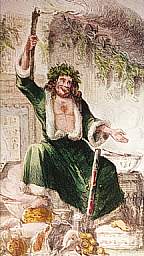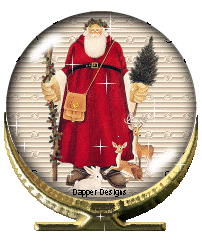| FATHER CHRISTMAS 
England’s Father Christmas became part of the greater European Santa Claus in the 1950's. But until then he was quite a different character. His origins were steeped in the Viking lore, brought by these people when they conquered Britain in the 8th - 9th centuries. Britain was a largely Saxon stronghold. Christianity came from two sides basically, the Celtic Church and the Roman Church. Although the Celtic Christians were brought in line with Roman practice from a decree at the Synod of Whitby in the 7th century, Christianity was still somewhat isolated from mainstream Europe. Many of the images in the Saxon churches were Byzantine in style, not Roman. The Byzantine Church had already begun to split from the Church in Rome, creating Eastern and Western Christians. Roman iconography was quite different to that of the Eastern Church, and Celtic imagery was harking back to what the early Church considered pagan imagery. While St Nicholas was enjoying cult status throughout Europe, with customs developing from as early as the 9th century, he did not arrive in Britain until much later. The Saxons welcomed King Frost, or Father Time, or King Winter. He would be represented by someone, given a fine hat or crown to wear,, and brought to their firesides. They believed that by welcoming the Winter as a personage, or elemental deity, that element would be less harsh to them, not quite so cold or wet. The Vikings brought their god Odin. Odin was the father of the gods, and he had twelve characters. The character for December was sometimes known as Yalka or Jul and his month was known as Jultid. From this, we get Yuletide. During December the Vikings believed that Odin would come to earth on his eight legged horse, Sleipnir. He was disguised in a long blue hooded cloak, and he carried a satchel of bread and a staff. His companion was often a raven or a crow. Odin was supposed to join groups around their fire, sitting in the background and listening in to hear if they were content or not. He would occasionally leave a gift of bread at a poor homestead. Here you can see already customs we associate with Father Christmas. The hooded figure, the secret visits, the leaving of a gift. Even after the Norman invasion in 1066, when the Normans effectively wiped out all the early imagery and replaced it with Roman style, still oaths were commonly sworn "By God and by Odin". Things changed only slowly. With the Normans came St. Nicholas. Viking and Saxon deities mingled with a Christian element to create a saintly Parish Visitor - a sort of medieval social worker! In England in the Middle Ages, a parish would hire an actor, or often a cleric from another parish, to dress in disguise, and visit homes to see how people were doing. Maybe someone’s children were sickly because they had no food, or a widow was not managing now her husband had died - He would report back to the parish priest, who would keep an eye on the situation. There are no records in Britain to tell whether he, as St Nicholas, was named as the gift giver for children, nor is it known whether religious establishments gave gifts to children in his name on the Feastday of St Nicholas, as was the practice in places such as Germany and Belgium. Many of these records would have been lost during the Reformation in the 16th-17th centuries. He was never given the task of filling stockings or suchlike, and he eventually degenerated into a sort of Master of Ceremonies for Christmas parties at the big houses. Father Christmas was banned by the Puritans under Cromwell in the mid-17th century. He went 'underground' along with minced pies, Christmas games, and the like. Occasionally secret publishers would print broadsheets with a verse about Father Christmas. He became the personification of everything the British people held dear about Christmas. 
Snowglobe from Dapper Designs |  Free Forum Hosting
Free Forum Hosting